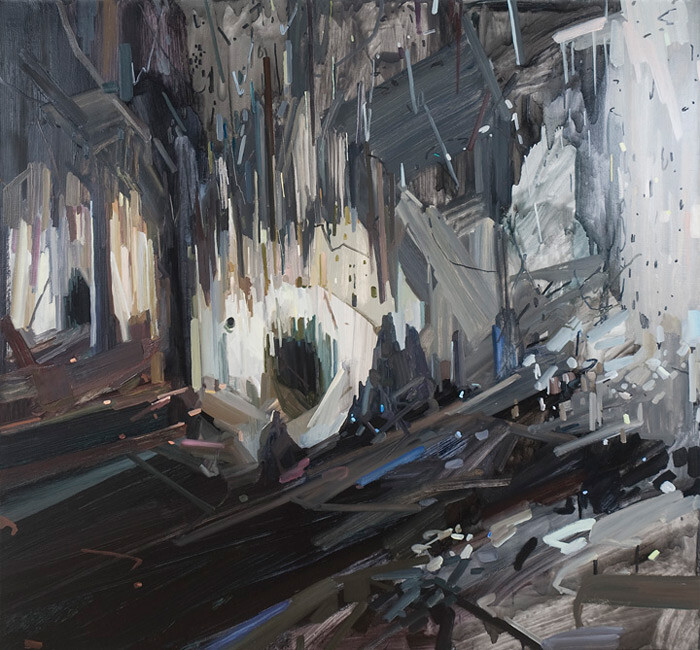Representational landscape is a risky genre. Its natural grandeur and boundless perspectives can seduce, instilling wonder and discovery. Yet more often, the genre triggers trite familiarity with both the subject and the material quality of the medium. Claire Sherman, however, with her nimble brushwork and compositional restraint, manages to navigate the perceptual underpinnings of landscape painting while confidently delivering its abstract realities. Back in the 19th century, Albert Bierstadt, a virtuoso at conjuring the extreme picturesque dazzling landscapes of the American West, elicited profound consternation from his critics. His depictions of glimmering mountain valleys, spectrum flecked waterfalls, and incandescent sunsets were shunned for their shameless idealism and their gaudy staging of the sublime. The only similarity that Claire Sherman shares with Bierstadt is an uncommonly large canvas size and the desire to demonstrate the profound magnitude in the natural world wrought by virtue of paint. Yet where Beirstadt employed fantastic illusionist devices to convey dense atmospheric perspectives, Sherman conversely models the physical properties of paint to constitute the organic and inorganic structures of landscape.
This is not to say that Sherman’s landscapes are flat. On the contrary, they are constructed, or, moreover, built, so that geological formations and foliage sit on the canvas surface in near relief. If it weren’t for the brazen figure/ground separation that divides the skies from the terrain in much of her painting, Sherman’s work could easily become codified as an all-over abstraction in the lineage of Hans Hoffman and Helen Frankenthaler. For example, Kavi Gupta Gallery’s adjunct space hosts a selection of Sherman’s etiolated paintings depicting caverns. Here, no single figure/ground event is distinguished within the composition, only a piecing together of warm and cool ashen brush strokes that suggest craggy accumulations of geological matter. Cave V (2010) is organized around the interplay of diagonal and horizontal linear elements that possess as much forceful dynamism as a Franz Klein gesture while still developing illusionary pockets of hollow space. The viewer is seduced into navigating the physical surface of quickly applied oil medium, the dense accretion of marks and the mirage of cavernous fissures insinuated by value contrast.
The gallery’s main space is anchored by two colossal paintings portraying plant specimens, a new metaphorical conceit for Sherman. These iconic flora compositions reveal only the tops of the plants, cropping them at the painting’s bottom edge so that there is no indication as to the context of the vegetation. Vertical saguaro cactus limbs that mimic human arms are starkly juxtaposed against a near white ground in a painting titled Cactus (2010). In Palm Trees (2010), two exotic trees are united at their lanky trunks by a mass of dead fronds that form a collar of hairy texture below their new green growth. Graphically depicted against a non-descript pale blue ground, the palm trees as well as the cactuses become cheeky human surrogates that lack the complexity that Sherman leverages from interrogating landscapes with a swift-moving loaded paintbrush. Her delft dance with gestural abstraction is sacrificed for the literalness of these outlandish specimens.
The most arresting landscapes in the exhibition are the bleached out abstractions titled Cliff II (2011) and Butte (2011). The rocky formations represented in both of these paintings carry the abstract interest driving Austrian painter Herbert Brandl’s fleeting and monumental landscapes. “I am a mountain seer and no mountain climber,” Brandl said, regarding his recent exhibition at the Albertina, Vienna. Based on her interest in both the physical topography of paint and the diversification of landscape types, Sherman, it would seem, is a “climber.”






